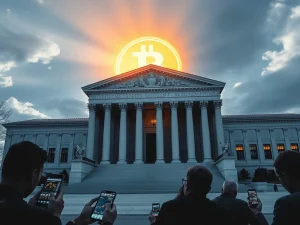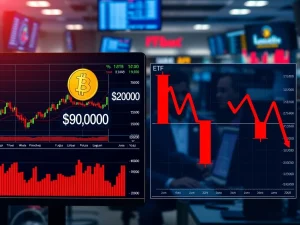Stablecoins: Unveiling Controversial Claims About US Debt and Dollar Dominance

The intersection of cryptocurrency, national debt, and international politics creates a fascinating, yet often complex, narrative. Recently, a senior Russian official made a striking claim. He suggested the United States might use **stablecoins** and gold to address its monumental national debt. This assertion immediately sparked debate among financial experts and policymakers globally.
Stablecoins and US Debt: A Controversial Claim Emerges
An adviser to Russian President Vladimir Putin, Anton Kobyakov, recently accused the US of employing a strategic maneuver. He claims the US aims to devalue its staggering $37 trillion in outstanding debt. Kobyakov suggests this strategy involves the calculated use of **stablecoins** and gold. He presented these views at a press briefing during the Eastern Economic Forum in Vladivostok, Russia.
According to Kobyakov, the US intends to “rewrite the rules of the gold and cryptocurrency markets.” He believes this move addresses a perceived decline in trust in the dollar. Kobyakov drew parallels to financial strategies from the 1930s and 1970s. He argued the US plans to solve its current financial challenges “at the world’s expense.” This, he explained, involves pushing everyone into a ‘crypto cloud.’
His theory posits that Washington could move its existing **US Debt** into dollar-backed stablecoins. This process, he claimed, would devalue the debt, allowing the US to effectively ‘start from scratch.’ However, Kobyakov did not provide specific details on how stablecoins would achieve such a devaluation. This lack of explanation leaves many questions unanswered about the proposed mechanism.
The Enigma of Devaluation Through Stablecoins
The concept of using **stablecoins** to devalue national debt is certainly provocative. Stablecoins are cryptocurrencies designed to maintain a stable value. They typically peg their value to a fiat currency like the US dollar. Some are backed by commodities like gold. Their primary purpose is to offer price stability, unlike volatile cryptocurrencies such as Bitcoin.
Kobyakov’s assertion suggests a complex financial engineering process. It implies a direct link between digital assets and sovereign debt management. However, traditional economic theory does not readily support such a direct devaluation method. Economists generally agree that a government’s ability to devalue debt typically involves inflationary policies or default. It does not usually involve converting debt instruments into a new currency format without explicit policy changes.
Therefore, the mechanism for stablecoin-induced debt devaluation remains highly speculative. It is a point of considerable debate among financial analysts. This claim highlights the growing influence of digital currencies in geopolitical discussions. It also underscores the differing views on their potential impact on established financial systems.
Washington’s Strategy: Reinforcing Dollar Dominance
US officials offer a contrasting perspective on **stablecoins**. They emphasize the role of these digital assets in strengthening the dollar’s global position. US Treasury Secretary Scott Bessent stated in March, “We will use stablecoins to do that.” This statement highlights a strategic intent.
Former House Speaker Paul Ryan further elaborated on this view in July 2024. He suggested that **stablecoins** backed by dollars could drive demand for US debt instruments. This, in turn, would reduce the risk of failed debt auctions. It could also prevent an attendant financial crisis. Ryan noted, “Stablecoins backed by dollars provide demand for U.S. public debt and a way to keep up with China.” This perspective positions stablecoins as a tool for economic stability and competitive advantage.
Washington has made considerable progress in this area. President Donald Trump signed the Guiding and Establishing National Innovation for US Stablecoins Act (GENIUS Act) into law in July. This legislative move signals a clear intent to integrate stablecoins into the US financial framework. It aims to ensure continued **dollar dominance** in the digital age. This proactive approach seeks to leverage new technologies to maintain the dollar’s global standing.
The Bitcoin Act and Future of US Financial Policy
Senator Cynthia Lummis’s proposed **Bitcoin Act** adds another layer to this discussion. This act suggests the US government buy 1 million Bitcoin over five years. It would then hold these assets for 20 years. Alternatively, the government could use them to retire outstanding federal debt. This proposal reflects a growing interest in incorporating decentralized digital assets into national financial strategy.
The **Bitcoin Act** represents a significant shift in thinking. It considers Bitcoin not just as an investment, but as a potential tool for sovereign debt management. If implemented, such a strategy could have profound implications. It might establish a precedent for other nations. It could also influence the global perception of Bitcoin’s role in traditional finance. The debate around this act underscores the evolving relationship between digital currencies and national economic policy.
Global Economy Shifts: Russia’s Stablecoin Ambitions
While the US explores its options, Russia is also advancing its own digital currency initiatives. In June, Russian state media reported on a new ruble-backed **stablecoin**, A7A5. This stablecoin is reportedly in development and set to launch on the Tron network. This move appears designed to reduce Russia’s reliance on US dollar-backed stablecoins.
Notably, Russia has utilized Tether (USDT), a prominent US dollar stablecoin, for settling oil trades with China and India. Developing its own stablecoin provides Russia with greater financial autonomy. It also aligns with broader de-dollarization efforts. This initiative highlights the growing trend of nations exploring central bank digital currencies (CBDCs) or national stablecoins.
Russia’s stance on cryptocurrency has also evolved. Initially, Russia banned crypto payments in 2022. However, it has since become more open to the sector. In May, Russia permitted financial institutions to offer crypto-based products to accredited investors. This policy shift indicates a strategic embrace of digital assets. It positions Russia to navigate the changing **global economy** with new financial tools.
Navigating the Complexities of Global Finance
The claims from Russia and the responses from US officials reveal a complex geopolitical and financial landscape. On one hand, we see accusations of manipulative financial strategies. On the other, we observe proactive measures to maintain economic leadership. The role of **stablecoins**, gold, and Bitcoin in these discussions is undeniable. They are increasingly becoming central to national economic strategies.
The current **US Debt** level, exceeding $37 trillion, provides a critical backdrop. This massive debt necessitates innovative solutions or at least robust discussions about financial stability. Both the US and Russia appear to view digital assets as part of their respective financial futures. Their approaches, however, differ significantly. The US seeks to leverage stablecoins to reinforce existing structures. Russia aims to build alternative financial rails.
These developments underscore a pivotal moment in the **global economy**. Digital currencies are not just technological innovations. They are becoming instruments of national power and economic policy. The ongoing debate about their use will shape international finance for years to come. Ultimately, understanding these claims and counter-claims is crucial for anyone interested in the future of money.
The world watches as these major powers navigate the complexities of digital finance. The outcomes will certainly impact global trade, investment, and geopolitical stability. The conversation around stablecoins, national debt, and dollar dominance is far from over. It represents a dynamic and evolving chapter in financial history.









